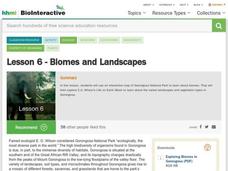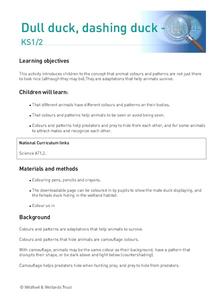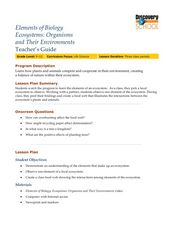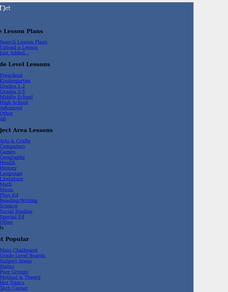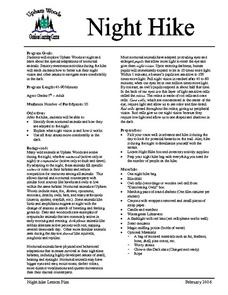National Wildlife Federation
Habitat Hunt
Put yourselves in their shoes—or, in this case, their paws. Learners assume the role of an animal and scan a habitat looking for features to fulfill their basic needs. Based on their findings, they decide if the habitat is a suitable...
ARKive
Temperate Rainforest in the Pacific Northwest
Explore the amazing temperate rainforest of the Pacific Northwest. Your class starts by investigating the animals and plants of the Northwest, specifically Washington, and then research an animal population common to the area. In small...
Curated OER
King of Beasts
Students conduct research on lions and their natural habitats and how zoos provide lions with more natural surroundings while in captivity. They draw a picture of a lion in a habitat of their choice and add details to the scene's...
Polar Bears International
Top of the World
Learn about polar bears and the Arctic circle with a lesson about the countries and conditions of the region. After examining how the area differs from Antarctica, kids explore climates, animals, and geographical position...
National Wildlife Federation
Massive Migrations: Grades K-4
Bird migration is a fascinating behavior. Budding scientists experience their own migrations using the school grounds for their flight patterns. They follow a map that leads them through a migration pattern that includes stops for...
Howard Hughes Medical Institute
Lesson 6: Biomes and Landscapes
Aside from the amazing animals in Gorongosa National Park, what else is there to discover? The sixth installment in an eight-part themed series contains an interactive map where scholars can learn more about the geographic features of...
Curated OER
Introducing NatureMapping
Students model the NatureMapping program in order to study habitats and biodiversity.
Curated OER
Ocean Friends Nametags
Students complete a number of activities to complete a study of ocean animals. They identify the animals, make nametags using appropriate colors, the animal habitats, and make a book by putting the pages in numerical order.
Curated OER
Wildlife Conservation I
Focusing on the wildlife in their area, learners identify endangered and threatened species and what these animals need to survive. While this lesson plan involves animals in the Long Island area, it could be adapted for use with any area.
Curated OER
Wildlife Conservation III
Discuss the importance of wildlife conservation. Learners talk about the animals and plants on the US Fish and Wildlife Services list of endangered and threatened species. Then, they engage in a detailed discussion of the reasons these...
Curated OER
Taming Wild Land
Third graders consider the habitat needs of living things and how extensive farming in an area can affect the plants and animals of a region. They participate in a simulation to show how changing the habitat in one area can greatly...
Curated OER
Habitat
Young scholars are able to define habitat. They are able to identify the four things that living things need to survive. Students are able to describe how living things are adapted to their habitats.
Curated OER
Habitat for Sale
Students are able to define habitat, and identify the four things that living things need to survive. They are able to describe how living things are adapted to their habitats.
Curated OER
Dull Duck, Dashing Duck
Students learn about animal camouflage. In this animal adaptations activity, students discuss the patterns and adaptations animals use to help them survive, discuss the uses of camouflage, visit a local wetland if possible, and...
Curated OER
Adaptations
Young scholars identify what adaptation is and to research a specific mollusk. They also identify and interpret how animals get their common and scientific name and why it is Latin. Finally, students draw their shell (mollusk) and name...
Curated OER
River Otter Adaptations
Learners study the body of the River Otter to understand animal adaptations to their habitats. In this animal adaptations lesson plan, students study the photo of the River Otter and discuss its body. Learners then play a game of...
Curated OER
Winter Animal Match
Students play a game. In this matching instructional activity, students learn about animals and their winter homes. Students match cards of animals with the cards of winter homes.
Curated OER
Carnival of Carnivores
Students research different species of meat-eating animals in their natural environments to create a Carnival of Carnivores exhibit for their classroom.
Curated OER
Organisms and Their Environments
Students study a local ecosystem and research the organisms to create a food web. In this ecosystem instructional activity, students view a video and answer questions. They visit a local ecosystem and make a list of organisms to...
Curated OER
Zoo Animal Facts
Learners create a fact sheet naming an animal's habitat, distinguishing characteristics, eating type, country of origin, and any interesting information that they research. They illustrate their fact sheet and sheets are compiled into a...
Curated OER
BIOMIMICRY, Housing Naturally: Habitat as Model
Pupils explore natural animal habitats. In this lesson on biomimicry and habitation design, students will use classroom and field examples to examine animal habitats. Pupils will construct a model of a natural animal habitat. This lesson...
Curated OER
Night Hike
Learners explore Upham Woods at night and investigate about the special adaptations of nocturnal animals. They identify three nocturnal animals and how they are adapted to the night. Students explain what night vision is and how it works.
Curated OER
Habitat Hopscotch
Students analyze different habitats. In this habitat lesson, students evaluate what animals need in their habitats. Students participate in the game Habitat Hopscotch.
Curated OER
Students Solutions - Saving Our Surroundings
Pupils explore the environmental impact of humans on the plants and animals in their state. In this environmental impact lesson, students use digital cameras to photograph plants and animals in their state. Pupils investigate the animal...





